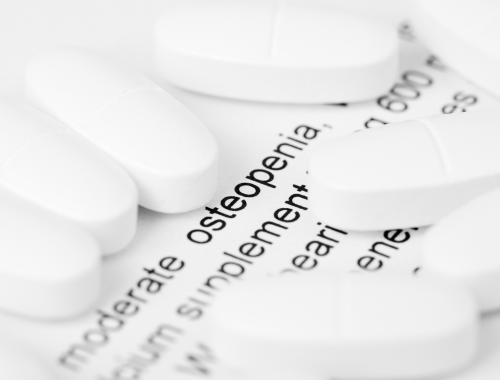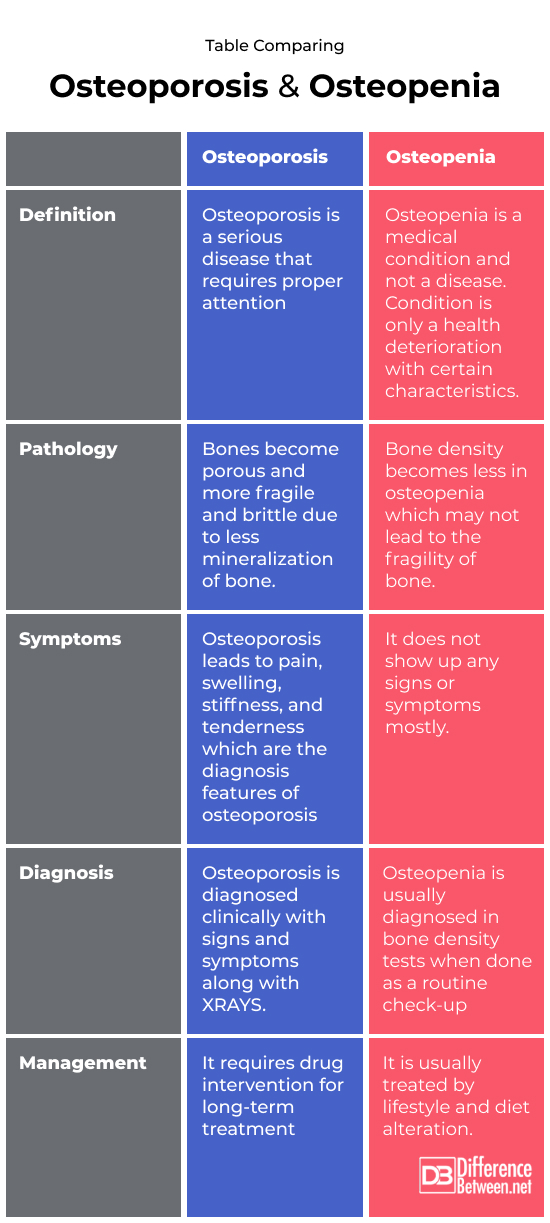Difference Between Osteoporosis and Osteopenia
Osteopenia is a condition that starts as the bone mass is lost and bones become weak. This happens mostly because of calcium deficiency and is seen commonly in increasing age. People having osteopenia are more likely to develop osteoporosis which is a bone disorder having a decrease in bone mass leading to alterations in bone anatomy and strength causing fractures.

What is Osteoporosis?
Osteoporosis is defined as reduced bone mass, and microarchitectural deterioration of bone tissue, leading to enhanced bone fragility and an increased risk of fracture. Bone is normally mineralized but is deficient in quantity, quality, and structural integrity.
Symptoms
Symptoms of osteoporosis are:
- Bone fractures occur rapidly even after mild jerks in different parts of the body, this is the diagnostic feature of osteoporosis.
- Height loss due to the reduces inter-disc spaces in the vertebral column.
- Chronic back pain
- Stooped/curved spine giving an S-shaped appearance.
- Gums recession
Causes
- Diet has a significant effect on your bone health. Taking less calcium intake in diet with lack of physical exercise or immobility is the major cause of osteoporosis
- This could be due to hormonal imbalances too. Like in females, deficiency of estrogen especially at the time of menopause makes the bones porous leaving pain and tenderness. The same happens in males where they lack testosterone leading to porous bones.
- Few inflammatory diseases can lead to osteoporosis like ankylosing spondylitis (where the cartilage between the joints reduce and become immovable) and rheumatoid arthritis (an autoimmune disease in which the immune system attack different joints of the body leaving stiffness and swellings in joint areas).
Risk factors
Discussed below are a few of the risk factors is osteoporosis:
Endogenous:
Asian females with thin stature and short physique are sure more prone to it. Patients with a family history are more likely to occur osteoporosis. It is also very commonly seen in old-aged women and women experiencing early menopause.
Exogenous:
Patients with low calcium intake with reduced physical activity are likely to develop osteoporosis. Cigarette smoking, alcohol abuse, aluminum antacids, surgical menopause, and steroid therapy are the other common risk factors.
Treatment
Osteoporosis treatment relies on the eradication of the cause:
- Adequate calcium and vitamin D intake with proper exercise and physiotherapy. Quitting alcohol intake and smoking cigarettes.
- Women with hypogonadism should be considered for hormone replacement therapy (HRT) with estrogen, men with hypogonadism are treated with testosterone.
- Treating underlying anti-inflammatory diseases with appropriate treatment approaches and corticosteroid therapies.
- Bisphosphonates are the drugs that inhibit osteoclasts (cells that induce bone resorption), they are commonly prescribed in osteoporotic patients

What is Osteopenia?
Osteopenia is a condition in which bone mineral density is low compared to normal at the age of 50 or above. The bones are not fragile as in osteoporosis they break easily but the density is less compared to the normal anatomy of bone.
Symptoms
- Osteopenia is usually asymptomatic, showing no signs and symptoms which is the reason it is unable to be diagnosed until and unless painless bone screening tests are done.
- The only symptom which could be visible is the loss of height due to a stooped (S) posture which is also indicative of osteoporosis.
Causes
Causes of osteopenia could be:
Medical Causes:
Eating disorders like anorexia starve the body of healthy nutrition required for strong bones. A few other causes are:
- Chronic celiac disease if untreated for long
- Hyperthyroidism
- Chemotherapy
- Certain drugs or medicines like steroids and anti-seizure drugs
Lifestyle Causes:
An unhealthy diet, lack of adequate exercise, and habits can lead to this condition, which is:
- Lack of calcium and vitamin D intake
- Inadequate exercise
- Smoking cigarette
- Alcohol consumption
Risk Factors:
- The most common risk factor of osteopenia is a female over 50 years of age.
- Fhashistory having thin bone density and fragile bones and females having early menopause are more susceptible to the condition.
- Poor nutrition in diet like less calcium and vitamin D intake in daily routine and less exercise can lead to osteopenia and other bone disorders as well.
- Smokers and tobacco consumers are likely to develop it too.
Treatment:
Management again depends on treating the symptoms:
- Healthy diet maintenance with adequate calcium intake and vitamin D supplements can minimize the condition.
- Proper exercise is advised.
- It is mainly treated with a diet and drug balance. Drugs like amino bisphosphonates are prescribed in most cases. Surgical intervention is not suggested at this stage.
Table Comparing Osteoporosis and Osteopenia:

Summary Of Differences Between Osteopenia and Osteoporosis:
In a nutshell,
- osteopenia is when the bones are weaker than normal but not to the limit that they fracture easily unlike osteoporosis where the bone mineralized density (BMD) is low so they may become fragile followed by fractures.
- Osteopenia occurs at a T-score between -1 to -2.5 whereas in osteoporosis it goes beyond -2.5.
- Osteopenia is less severe compared to osteoporosis (having pain, stiffness, and tenderness)
- Osteopenia can be controlled and treated by lifestyle changes and calcium/vitamin D supplements whereas osteoporosis needs drug therapy too along with these precautions
FAQs
At what point does osteopenia become osteoporosis?
In osteopenia, bones are weaker and thinner so they can fracture easily. If they keep getting thin Nd fragile with time, it can lead to osteoporosis. Also, in osteopenia a T-score is between -1 till -2.5, if the range succeeds below -2.5, it can lead to osteoporosis. T-score indicates bone density scale.
What is the best treatment for osteopenia?
Osteopenia can be managed with diet alteration with vitamin D consumption by taking sunlight and calcium suspensions. Regular Exercises are also advised. A balanced diet with alcohol and smoke cessation.
What is the most common cause of osteopenia?
Age is the most common factor; bone mass becomes thin and weak and bone destruction happens faster than bone formation
What is the difference between osteoporosis osteopenia and osteomalacia?
Osteopenia is a conditioconsistinged of decreased bone density, osteoporosis is a disease where there is less bone mass and strength but any bone which is formed is as fully mineralized as normal bone whereas osteomalacia is also a disorder where the bone is less mineralized than the normal leading to fracture.
What is the best vitamin for osteopenia?
Vitamin D helps strengthen the bones by absorbing phosphorus and calcium from food into the bloodstream and later into the bones.
What foods should be avoided with osteopenia?
Salt, sugar, soda, and alcohol are a few which should be avoided in osteopenia as they all remove calcium from the bones and make them weaker.
- Difference Between Cystocele and Rectocele - September 8, 2023
- Comparison Between DHEA and DHEA Sulfate - September 1, 2023
- Difference Between Osteoporosis and Osteopenia - June 14, 2023
Search DifferenceBetween.net :
Leave a Response
References :
[0]Danish, M. I. (n.d.). Mohammad Inam Danish short textbook of medical diagnosis and treatment no restriction: Share and care: Free Download, Borrow, and Streaming. Internet Archive. Retrieved April 16, 2023, from https://archive.org/details/MohammadInamDanishShortTextbookOfMedicaDiagnosisAndTreatmentNoRestriction
[1]MediLexicon International. (n.d.). Osteopenia vs. osteoporosis: What is the difference? Medical News Today. Retrieved April 16, 2023, from https://www.medicalnewstoday.com/articles/osteopenia-vs-osteoporosis
[2]Osteoporosis. health direct. (n.d.). Retrieved April 16, 2023, from https://www.healthdirect.gov.au/amp/article/osteoporosis
